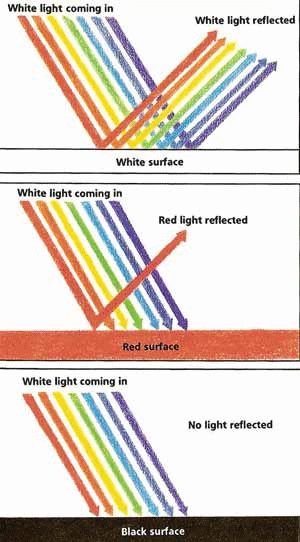 Different colours of light getting reflected from coloured surfaces
Different colours of light getting reflected from coloured surfaces
On the atomic scale, light is reflected from objects because of the electron configuration of their molecules.
The outer electrons that buzz about the atomic nucleus can be forced into vibration by the vibrating electric fields of electromagnetic waves.Different materials have different natural frequencies for absorbing and emitting radiation. In one material, electrons oscillate readily at certain frequencies; in another material, they oscillate readily at different frequencies.
The color of the objects which we see are largely due to the way those objects interact with light and ultimately reflect or transmit it to our eyes. The color of an object is not actually within the object itself; rather, the color is in the light which shines upon it and is ultimately reflected or transmitted to our eyes.
Any visible light which strikes the object and becomes reflected or transmitted to our eyes will contribute to the color appearance of that object. So the color is not in the object itself, but in the light which strikes the object.
The color of a transparent object depends on the color of the light it transmits. If the object is transparent, then the vibrations of the electrons are passed on to neighbouring atoms through the bulk of the material and re–emitted on the opposite side of the object. Such frequencies of light waves are said to be transmitted. A red piece of glass appears red because it absorbs all the colors that compose white light, except red, which it transmits.